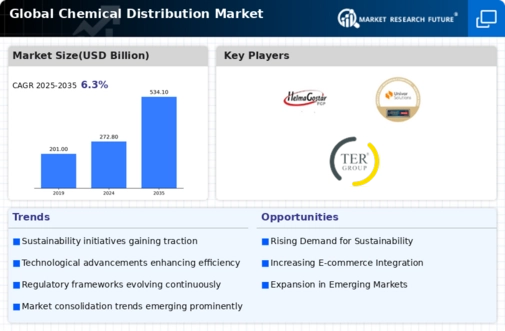Top Industry Leaders in the Chemical Distribution Market

Chemical Distribution Market
The chemical distribution market is a churning vortex of opportunity and challenge. Within its depths, established titans battle nimble upstarts, all vying for a share of the chemical currents powering diverse industries. To understand this dynamic ecosystem, we must dive deep, analyzing the strategies, trends, and recent developments that shape its ever-shifting landscape.
Strategies Propelling the Titans:
1. Charting New Waters: Diversification: Gone are the days of one-size-fits-all. Giants like Brenntag and Univar are casting wide nets, expanding their portfolios to encompass specialty chemicals, life sciences products, and even green chemistry solutions. This mitigates risk and capitalizes on new growth areas.
2. Expanding the Map: Geographic Exploration: Emerging markets like China and India are fertile ground for expansion. Nexeo, for instance, has planted its flag in these regions, building robust logistics networks and strategic partnerships to tap into their burgeoning demand.
3. Riding the Digital Wave: Embracing Technology: E-commerce platforms and AI-powered supply chain management are reshaping the landscape. Deutsche Bahn Cargo, for example, harnesses AI to optimize rail freight transportation, ensuring efficient and cost-effective chemical delivery.
4. Mergers and Acquisitions: Navigating by Consolidation: Sometimes, the fastest way forward is to join forces. Consolidation through strategic acquisitions allows players to expand market reach, acquire new technologies, and eliminate competition. Recent examples include Univar's acquisition of Nexeo and Lindsay Corporation's merger with Nufarm.
5. Charting a Sustainable Course: Embracing Green Chemistry: The rising tide of environmental consciousness is forcing distributors to adapt. WESCO International, for instance, is leading the charge by investing in renewable energy solutions and offering eco-friendly chemical alternatives, catering to customer needs while aligning with ESG goals.
Factors Anchoring Market Share:
1. Cargo Type: Specialty vs. Commodity: The chemical you carry defines your course. Specialty chemicals, with their higher profit margins and complex logistics, offer greater differentiation opportunities compared to commodity chemicals. Companies like Ashland Global Holdings have charted their course in this lucrative segment.
2. Customer Focus: Building Lasting Partnerships: In a crowded sea, offering value-added services like technical support, inventory management, and regulatory compliance becomes your compass. Brenntag's extensive customer service network serves as a beacon in this regard.
3. Streamlining the Voyage: Operational Efficiency: Smooth sailing requires cost-effective logistics, optimized warehousing, and proactive risk management. Univar, with its vast scale and innovative approach, exemplifies this strategy.
4. Navigating Regulatory Currents: Staying Compliant: The regulatory landscape, with its ever-shifting tides, can be treacherous. Companies like CHEP offer specialized services to help distributors navigate these complexities, ensuring smooth passage through legal and compliance channels.
5. Embracing the Technological Winds: Digitization and Innovation: The industry is being swept by a wave of digital transformation. HCS Group, for example, is harnessing blockchain technology to improve supply chain transparency and traceability, ensuring trust and efficiency in every chemical transaction.
Key Players:
- Helm AG
- Univar Inc.
- Brenntag AG
- Nexeo Solution Holding LLC
- ICC Chemicals, Inc.
- Barentz B.V.
- Azelis Holding S.A.
- Omya AG
- Jebsen & Jessen Offshore Pte. Ltd.
- TER Group
Recent Developments:
July: The EU proposes stricter REACH regulations, sending choppy waves through the market as distributors grapple with the potential impact on certain chemicals.
August: A global cyberattack disrupts operations at major players, highlighting the need for robust cybersecurity measures to ensure smooth sailing in the digital age.
September: Rising energy costs and supply chain disruptions lead to price hikes for some chemicals, forcing distributors to adjust their course and adapt to the changing market currents.
October: New trade agreements between the US and China offer a potential tailwind for cross-border chemical trade, benefiting distributors with strong regional networks and their ability to navigate these new trade routes.
November: A major investment firm acquires a leading online platform for chemical sourcing, indicating a growing interest in e-commerce solutions and signaling a shift towards online marketplaces in the industry.
December: A consortium of chemical distributors announces a collaboration to develop a blockchain-based platform for managing hazardous waste disposal, showcasing a collective effort towards sustainability and a commitment to navigating the environmental challenges facing the industry.









